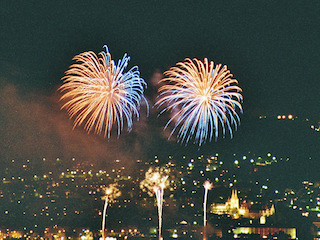
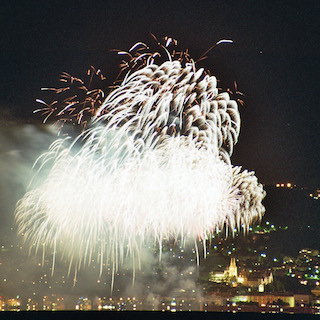

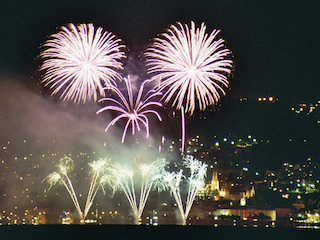
Fireworks are very nice photographic opportunities if you like shooting at night. Unlike lightning strikes, the nice thing about fireworks is that they are usually very well planned and you have time to look for a suitable location and prepare all your equipment in advance.
Of course, you need a SLR camera (single lens reflex), a tripod and a remote shutter control. The majority of compact cameras won't work. A pocket flashlight is also very useful to set up all your stuff in the dark and help you finding little things like the lens cover, if you drop it on the ground...
So, the first thing to do is install your camera on a steady tripod, connect the remote shutter and select a suitable lens to have the whole fireworks in the field of view. This choice is not easy: you'll probably already know the location from where wireworks are shot, but it's very difficult to predict the height they will fly. If it's a show that is repeated every year, experience from the past events can be very helpful, if not, try with a zoom lens so you can modify the field of view during the show if it doesn't fit your frame.
Fireworks are bright and last a few seconds: in order to keep the background dark and avoid burning the image, I usually select a low ISO sensitivity (let's say ISO-100 or so) and a fairly wide f-stop (f/4 to f/8). Of course, these settings are very personal and depend on the final result you're trying to achieve, but they work fine for me. Select the "Bulb" mode of your camera and dial in manually the f-stop you like; the exposure meter of your camera won't work anyway.
Now adjust the focus of your lens. If you have a very bright lens and a professional camera you may have a chance of getting the autofocus to work at night, but if you do, you'll probably don't need to read this page... The autofocus of an amateur SLR camera with a cheap lens doesn't work in the dark, so you'll have to adjust the focus manually. For this, you need to get your eyes used to the darkness for at least fifteen minutes before you can see something in your viewfinder. When the focus is adjusted (no matter if manually or with the autofocus) switch your lens to manual focus mode to prevent the autofocus from trying to readjust every time you press the shutter and wasting precious time. Simply adjusting the focus ring on the ∞ (infinity) mark is not accurate enough and your pictures will be blurred. Another way is to adjust the focus before sunset, than switch the lens to manual focus and wait for the beginning of the show without touching it again.
Than comes the tricky part: shooting. This takes some practice since you have to be more or less in sync with the fireworks. If you expose for too long, different fireworks will be superposed and the result becomes to cluttered, if you expose to shortly you just have short bright segments that don't look nice. I usually try to open the shutter when I see a firework going up in the air before it explodes (they are not bright, but often you can see them) and keep the shutter open until almost complete burning of the firework, or a bit before. If you can't see them flying up, you can still try to guess the rhythm. You can't rely on sound, since it always arrives a few seconds later. If you opened the shutter for several seconds and nothing (interesting) happened, you'd better release it and take a new picture, otherwise your background will be overexposed (or too bright). Beware of the smoke: when a lot of fireworks are fired in a short period of time the sky gets smoky and your images don't look as nice; sometimes is better to wait for the smoke to dissolve a bit.
The following images were my first attempt: they were shot on Agfa ISO-100 negative film using a canon EOS 300 camera. I used a 70-300 mm zoom lens between 200 and 300 mm opened at f/5.6, but the fireworks where too fast to write down all the exposures times: they were between 2 and 20 seconds.
One of the problems negative films is that when they're developed and printed, the majority of the labs will correct the exposure automatically and your nice black background will end up greyish (which is the case in the four pictures below). Using slide film is a solution, but nowadays digital SLR are definitively a better choice: you don't have to wait a few weeks to get your films developed, you don't need to load a new film during the show and you can see the result straight away and do adjustments if you're not happy with your images.
The following pictures were taken on August 1st, 2005. The city in the background is Neuchâtel (Switzerland) and was about 6 km away from my location, just across the lake. The lake is visible as a black area at the very bottom of some images.
 |
 |
 |
 |
I returned to same location three years later with a digital SLR (an EOS 350D) and tried again. This time the problems with the development exposure disappeared and I was more happy the result, now black is black. A nice thing of digital cameras is that they record the exposure of every single picture, so you don't have to write it down. Still, it's not easy to see if the image is in focus on the small screen of the camera and you have to magnify the image to see if it's sharp.
For the following two pictures I was taken by surprise: I heard a few loud bangs and looked through my window: somebody was playing with fireworks in the neighbourhood: I just had the time to grab the camera, set up the tripod and start taking pictures. This time I used a wide angle lens because I was much closer. I couldn't fine tune my adjustments, because the show only lasted for a few minutes, but still I'm happy with the result. These images were taken with an EOS 350D as well.
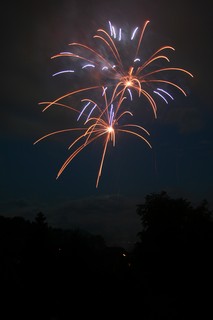 30 mm, f/3.5, 10 s, ISO-100 |
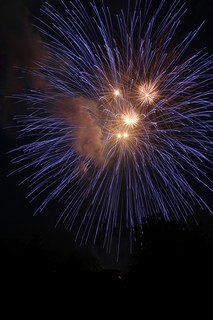 30 mm, f/5.6, 4 s, ISO-100 |
| Home | Optics | Page hits: 017917 | Created: 10.2005 | Last update: 11.2011 |